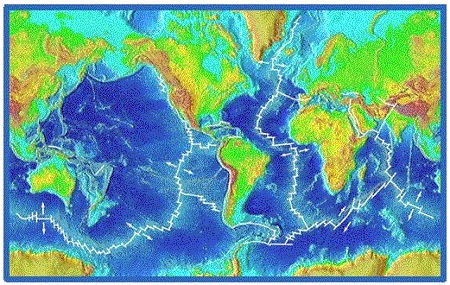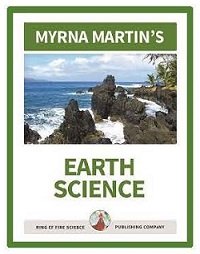Exploring Planet Earth
Discovering new facts about the oceans
Scientists gather facts about Earth
New facts are constantly being
discovered as scientists research and gather new information about our planet. Did
you know that new evidence is being discovered about coral reefs and their
importance to the ecosystems in the oceans?
Deep water corals
For a long time, it was believed
that coral reefs only formed in shallow water. Today we know that deep water corals
grow in all the world’s ocean basins. These corals grow on continental shelves,
continental slopes, ocean canyons and on tall seamounts. They have even been found off the coast of
Antarctica.

Map of the global mid-ocean ridge system in all the oceans NOAA
Earth is known as the blue planet
70% of Earth is covered with water
Earth is known as the blue planet
because approximately 70% of the planet is covered with water. The oceans
influence the way we live and where we live. According to NOAA, as of 2018,
less than 5% of the seafloors had been explored. Oceanographers like to say we
know more about the dark side of the Moon than we know about the oceans. We
know even less about the seafloors.
Earth’s Tectonic Plates
Tectonic plates cover the Earth's surface
Tectonic Plates are the plates that cover the Earth's surface. There are seven major plates and several smaller plates. The 7 major tectonic plates are the African plate, Antarctic plate, Eurasian plate, Indo-Australian plate, North American plate, Pacific plate and the South American plate,
Moving plates
Prior to World War II people did not
know that tectonic plates could move on the surface of the Earth. Abraham
Ortelius in 1596 speculated that continents might drift to different places. No
one followed up on his ideas until 1912 when Alfred Wegener proposed his Theory
of Continental Drift.
Magnetite in basalt
Magnetite in basalt lines up with
magnetic north when it is erupted at a divergent boundary today. Scientists
discovered that reversals in the magnetic orientation of the Earth reversed on
both sides of a divergent boundary. Dating the rocks in the reversals and they were
the same age. These findings led to the Theory of Plate Tectonics.
Satellites today track the movement of tectonic plates around the globe.

I think you will like our Earth Science book because it has so much information and fascinating facts about our planet. Chapters in the book include Plate Tectonics, Volcanoes Worldwide, and Marine Habitats. Myrna Martin

Click for More Information and to Order
The Global Mid-Ocean Ridge System
New planet Earth facts are being discovered
Scientists on all the continents are
researching and finding new planet Earth facts that help us understand what a
unique planet we live on. One of the discoveries made about our planet in the
last century was the global mid-ocean ridges system.
Divergent boundaries
Divergent boundaries are located in all
the oceans. These boundaries create new seafloor as magma from the upper mantle
flows out of a vent onto the seafloor. As the seafloor spreads apart and
increases in size it forms a mountain range the length of the divergent boundary.
All of the mountain ranges connected just like the oceans. The average height
of the mountain ranges is 2500 meters. The Cayman Trough, part of the ridge
system, is 4000 meters deep.
Length of global mid-ocean ridge system
The total length of the global mid-ocean
ridge system is 65,000 km long. This explains how seafloor spreading cause
tectonic plates to move around on the surface of the Earth.
Mid-Atlantic Ridge
Divergent boundary in Atlantic Ocean
The Mid-Atlantic Ridge is a divergent
boundary that runs down the length of the Atlantic Ocean. Iceland, in the North
Atlantic Ocean, is one of the only places on Earth you can view the global mid-ocean
ridge system at sea level. Iceland is still growing in size and is part of the divergent
boundary in the Atlantic Ocean between the North American Plate and the Eurasian Plate.
Each year the basin of the Atlantic Ocean increases in size 2.3 centimeters as new
seafloor is created at the Mid-Atlantic Ridge.
Planet Earth links
What is the lithosphere Find out if you know the two types of crusts that make up this layer of the Earth and which one is younger?
What are Northern Lights? Find out how the solar wind powered, by great storms on the Sun, create the Northern Lights. Learn more about this phenomena on our What are Northern Lights Planet Earth Facts page.
What is the asthenosphere? Find out why scientists say the rocks in the asthenosphere has properties like silly putty.
What is a polar Front? Find out what happens when a cold air mass from the poles meets a warm tropical air mass!
What are horse latitudes? Find out where the Horse Latitudes are located and how they got their unusual name.
What is the Earths crust? Do you know where the youngest crust on our planet is located and how it forms?
What are Earth's interior layers? Our planet is made up of many layers and scientists working as detectives are uncovering its secrets.
Layers in the mantle Is the mantle molten rock or solid rock? Find out what we know about this large layer of the Earth.
Fiery volcanoes in Iceland Did you know volcanoes in Iceland formed because of the Mid Atlantic Ridge and a hot spot?
Tectonic plate boundaries Find out about the major types of crustal plates and the boundaries around them.
The Earth's Atmosphere Find out which layer meteors burn up, where the International Space station is located and more on this Planet Earth Facts page
KIDS FUN Science Bookstore
Check out Myrna Martin's award winning textbooks, e-books, videos and rock sets. The Kids Fun Science Bookstore covers a wide range of earth science topics. Click here to browse.










